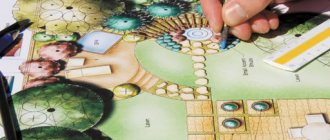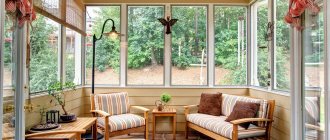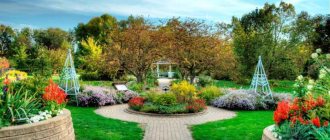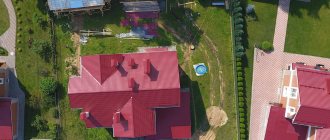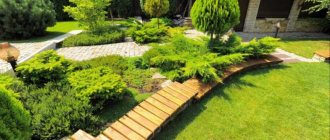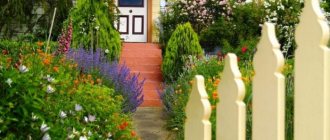A person is closely connected with nature, which is why when he gets a dacha or a house with a small plot of land, the desire to create the garden of his dreams awakens in him: it can be a simple vegetable garden with a garden, intricate interweaving of lawns and paths, or a simple estate in the Russian style. To bring your ideas to life, it is very important to choose the right style for the future garden, according to the scientific style of landscape design. The word style itself is a set of creative techniques and ideas, determined by the unity of artistic content and theme. It is necessary not only to correctly apply planning techniques, but also to decide on the color scheme, select plants, small architectural forms, the type of decorative paving, and garden equipment.
It is known that garden styles have existed since time immemorial: it is enough to recall the legendary wonder of the world - the Gardens of Babylon, the description of which has survived to this day. In Ancient Greece, Egypt, and Rome, gardening art also existed, which became the basis for the formation of classical styles. Over time, the principles have transformed, and the fashion for decorative elements changes tirelessly. Recently, people's interest in traditional styles has been growing - for example, the classic noble estate - there are gardens filled with flowers, a small pond, a pair of snow-white birch beauties, and lawns planted with wildflowers. Both Mediterranean and oriental motifs are interesting.
Decorative details of the garden also attract attention - unusual flowerpots, sculptures, flowerpots, bridges; bird feeders and birdhouses are actively used in gardens. The fashion for sundials is returning - a trend from Europe, however, now they play not so much a practical role as a decorative one. Green sculptures are also a new-fangled element - and these can be either intricate clipped figures, or ordinary shrubs, and climbing plants grown on a metal frame. In any case, existing trends should not put you in strict limits; it’s time to show your imagination and decide on bold experiments.
Conventionally, all styles of landscape design are divided into 2 groups: regular and landscape. If regular styles are characterized by the presence of some kind of pattern and strict geometry, then landscape styles emphasize the closeness of man to Mother Nature and allow all ideas to be realized. Let's look at each of the styles in more detail.
Regular style
Classic or regular style creates a feeling of solidity, order and solemnity. This style implies clear lines and strict symmetry in the layout. The main elements of the concept are considered to be the presence of open space, ponds and fountains of predominantly rectangular shape, smooth parallel or perpendicular paths, and curly trimmed evergreen bushes.
The bush looks great in the center of the flower bed, especially if it is trimmed into a ball, cone or other unusual shape. Caring for a garden in a classic style is comprehensive. Constant trimming of shrubs and mowing the lawn is required to keep the garden looking beautiful. The classic style creates the feeling that nature has completely submitted to man, and the location of every pebble and flower is carefully thought out.
High-tech style
This is the youngest of the landscape styles; it represents a set of design solutions that provide comfort and a minimum of garden maintenance. Modern garden style involves the use of materials such as concrete, metal, plastic, polycarbonate.
It is characterized by bright functional lighting, expressive lines, contrasting colors, and regular geometric shapes.
Asymmetry is allowed if it merges into a single picture. For lighting, façade illumination and solar-powered lamps are used. For landscaping, it is better to give preference to trees with an original crown shape and plants with rich colors.
For landscaping the site in a modern style, weeping birch, ornamental apple trees, blue spruce, barberry, and rhododendron are used. Abstract sculptures are suitable as decorative elements. As part of the modern style, ponds with a concrete or metal frame of the original shape are preferable.
Tyrolean
Setting up a little Switzerland is a good idea for owners of a small plot in a mountainous area with significant elevation changes and a heavily rugged landscape. If there are conifers and ground cover plants all around, that’s generally great. Mountains can be added by bringing more rubble and boulders of different shapes. With their help, it is not difficult to build an alpine slide or rock garden - the main element of this design trend.
A chalet-style country estate requires almost no maintenance. It should look as if it arose by itself, at the behest of nature, and its natural beauty was not touched by human hand.
English style
The traditional English or landscape garden style has its roots in British culture. A site arranged in this manner is full of alluring charm.
The main task of the English style is to imitate the natural landscape. The style is characterized by asymmetry; the main features of this style are vertical gardening, a neat lawn, the absence of strict geometry, winding paths, benches made of natural materials, tall and shady trees.
A small pond with aquatic plants and a weeping willow is desirable. The style does not imply straight lines and outlines, figuratively trimmed trees and symmetrical paths. Its task is to preserve the naturalness of the plantings. Style dictates the selection of plants that grow well without direct sunlight. These are bright primroses, roses of different shades, violets, forget-me-nots, rosemary, verbena.
Ecostyle
The second name of this style is naturgarden. Recently, its popularity has been increasing, since the main idea of designing a site in this case is the maximum naturalness of the landscape. The territory looks like a separate ecosystem consisting of interconnected objects.
Did you know? The famous Roman ruler Claudius Caesar, who lived at the beginning of the 1st century. n. e., was fond of the art of landscape design. He independently decorated his garden with various varieties of roses and other decorative objects.
Main characteristics of eco-style:
- For decoration, only natural materials and plants characteristic of a particular region are used;
- the original state of the relief is preserved;
- the use of garden flowers in combination with wild plants and stones;
- lawns have a natural appearance, covered with wild grass;
- garden paths are moderately winding, with unevenness and ledges, intermittently paved with stone tiles;
- the predominance of forest trees and shrubs with a natural-shaped crown;
- simple and practical furniture made of wood or wicker;
- the presence of a decorative stone hearth;
- a small pond or swamp surrounded by reeds with a simple wooden bridge;
- the use of decorative snags and stumps of unusual shapes;
- sawn tree trunks are used as benches;
- the presence of bird feeders, decorative beehives or homemade lanterns made from bottles suspended from tree branches.
Mediterranean style
The style reflects Mediterranean culture and combines elegant details with elements of nature. This style is inspired by Mediterranean landscapes.
For landscaping, citrus fruits, grapes, succulents, lavender, sage, and rosemary are used. The garden is decorated with gazebos covered with climbing plants.
All details work to enhance the relaxing atmosphere. Like Mediterranean cuisine, the garden style is also a mixture of Southern Italy and the dry regions of Spain. Integral details include gravel paths, terracotta pots, ceramic tiles and a comfortable seating area.
Dutch style
This style is directly correlated with the nature of Holland and its landscape. The Dutch were forced to conquer every piece of land from the sea, so their gardens are very small.
This style is associated with tulips, mills and canals. Essential features of the Dutch style are careful zoning.
In addition, ordinary trees are replaced with dwarf trees, perfect order is maintained on the territory, every square meter of the site is used to the maximum. Bright color accents, original garden figures and art objects are also used to decorate the garden.
Minimalist style
A garden in this style is laconic and expressive in its simplicity. This is perhaps one of the most complex styles, mainly because it uses a minimal number of components that can convey so much.
Minimalism does not tolerate pretentious textures of materials, color elements should not be bright and conspicuous, garden paths should be smooth with accentuated contours. When choosing plants, it is better to give preference to cypress, thuja, maple, and juniper. Flowers in ceramic or concrete containers of strict geometric shapes will fit organically.
Garden furniture should also be decorated in a minimalist style. This could be simple lightweight aluminum or plastic furniture.
Colonial Landscape Design
Colonial style dates back to the time when Europeans arrived in America and had to re-adapt not only to a new way of life, but also to a different climate. The style combines two different cultures: the colonialists and the aborigines.
The diversity of local flora and the multinationality of the colonialists led to a striking style, which is characterized by comfort and slight carelessness. Characteristic elements of a colonial garden: clear zoning, stone paving stones, sundials, fountains, symmetrical straight gravel paths between flowerbeds, a low white fence.
The obligatory gardening part of the site in the colonial style is an echo of how the first settlers, in addition to the decorative purpose, also attached practical significance to the garden.
Landscape design in Art Nouveau style
One of the most elegant styles originated in interior design. The Art Nouveau or Art Nouveau style that dominated the early 20th century had a strong influence on culture in general and also on the world of landscape design. Simplicity is the principle of designing a garden in a modern style.
The garden, designed in the Art Nouveau style, is devoid of decorations and adheres to strict symmetry. The pond is usually located in the center of the site. The paths are paved with tiles with geometric patterns or slabs of only two colors are used - black and white.
Accessories are allowed, but not in abundance. A minimum of plants and a limited number of small architectural forms are used. These are simple fences and black trellises on white walls.
Classical
It has many alternative names: regular, traditional, formal, palace.
Classic landscapes can be seen in the heart of Versailles, Sans Souci, Peterhof and other famous park complexes. This trend is characterized by clear symmetry, monumentality and chic. Long alleys lead the guest to the center of the composition - a fountain, an antique statue or a lush geometrically correct flower bed. Neatly trimmed hedges form bosquets - “rooms” decorated with flowers and benches.
The classic style of landscape design does not lose popularity because of its representative luxurious beauty, but it is extremely difficult to maintain and requires space and appropriate architectural framing.
Scandinavian style
Scandinavian design is known all over the world and combines functionality with naturalness. The design is flexible and lively, without clear geometric shapes or bright accents. Despite its apparent simplicity, the style is phenomenally beautiful and takes the best from northern landscapes: Norwegian fjords, Finnish forests, Icelandic volcanic highlands.
A characteristic feature of the style is boulders and flat stones of equal size, stacked in the form of steps.
The concept of the Scandinavian style is also implemented by coniferous and dwarf trees, fruit and berry crops, ornamental cereals, paths paved with stones of various sizes, grottoes and stone arches, wooden sculptures, rattan garden furniture.
Vertical, horizontal, volume and four elements
All components of landscape design successfully fit into the rule “combine top, bottom and shape”, and also symbolically support 4 natural elements (wood, water, stone, air) when filling the landscape. An additional component that gives the ability to draw any geometric shapes and emphasize accent objects is light.
| Air | Water | Stone | Tree | Light | |
| Horizontal | Panoramic view | Ponds Reservoirs Streams | Garden paths driveways Parking areas Patio | Ornamental shrubs Creeping plants | Illumination of paths Artificial lighting of reservoirs |
| Vertical | “Light at the end of the tunnel” - a skylight at the end of the alley inviting you to walk | Cascades Waterfalls | Retaining walls Columns Stone arches | Full Size Trees Vertical Gardening | Freestanding lanterns |
| Volume | Open spaces (lawn, paved area) | Volumetric fountains | Garden stoves Sculptures Fire pit | Topiary MAFs (gazebo, pergola, lattice canopies) | Light figures Light design of green spaces |
When developing a landscape project, it is necessary to connect the vertical and horizontal planes with each other, emphasize the required volume, and create a single space where nothing will be discordant with the overall style solution.
Chinese style
Chinese style is based on the teachings of Feng Shui. When planning a site, the main feature should be the naturalness of the landscape, the balance of shapes and sizes.
Chinese gardens are a spiritual sanctuary, a place where there is a keen sense of connection with nature, as well as a world in miniature. The most important principle of the style is the harmonious combination of garden landscapes and architecture. The lines of the buildings follow the natural lines of the surrounding landscape. The accents of the Chinese style are stones and water, while plants play a secondary role.
Tuscan style
The roots of this landscape design come from the Tuscany region, located in southern Italy. This style recreates the atmosphere of the Old World.
The style combines rustic style with the elegance of the Italian Renaissance. The use of brick, forged elements, stone, and authentic Tuscan plants, including cypress, citrus fruits, olives, grapes, rosemary, and lavender, is encouraged. Natural yet refined materials create a relaxing atmosphere with a special charm. Bright details of the exterior - terracotta pots, a decorative pond with amphorae, elements of the ancient era.
Rustic
Country music can be found everywhere; the style has many branches. In the American outback, the landscape will probably be complemented by a barn, a stable, an old cart and a barrel, and in the Russian open spaces in any yard you will be greeted by a well, a tine, wooden benches, an apple orchard and a garden scarecrow.
The rustic style implies a sweet, cozy negligence: a lack of symmetry, fruit trees and flower islands scattered here and there, decor made from pottery and household utensils, winding paths paved with stones through which grass grows.
This design makes it easy to decorate a plot with a small area and a modest wooden cottage. Taking care of the estate will also not be difficult.
Japanese landscape design
The Japanese garden is characterized by restrained purity of style, compositional precision and asceticism. No details of the landscape should distract from the contemplation of natural harmony or immersion in one’s own thoughts. The manner is based on Buddhist and Taoist philosophy.
Japanese style strives to create miniature copies of nature itself. This practice is an art form in the Land of the Rising Sun. Elements of a Japanese garden imitate or symbolize natural elements. The delicate combination of stones, calm or running water, and plants creates a special world.
The stylistic features of the Japanese-style garden design are the asymmetrical layout of the site, paths paved with stones, a natural pond, sand decorated with wave-like patterns and symbolic compositions made of natural stone.
Plums, maples, pines, cherries, bamboo, pine trees, willows, peonies, chrysanthemums, and bonsai are used for landscaping. The view created in a Japanese garden is far from real nature, but is based on it. Japanese gardens are not meant for walking, but for contemplation. When creating a Japanese-style garden, a sense of proportion and taste is important.
Moorish style
The garden in this style is closed from prying eyes. This is the rightful heir to the Hanging Gardens of Babylon. Hidden behind high walls, this exotic oasis is filled with oriental luxury, bright colors, sweet aromas, lush greenery and fountain water sparkling in the sun.
The Moorish garden amazes with its pristine beauty; it seems to invite you to enjoy life and continuous pleasures. The geometric regularity of the landscape is combined with a large amount of vegetation. The paths are lined with ceramic tiles, the exterior decoration is fruit trees and roses with a thick, exciting aroma.
The center of the garden is a pond or fountain. The presence of a patio is a charming feature of the Moorish garden. Other important elements of this concept include wrought iron elements, wall fountains made of mosaic tiles, benches and tables covered with mosaic tiles.
Historical excursion: descending into the depths of centuries
The beginnings of landscape design appeared immediately as soon as primitive people decided on the concept of their own home: paving the area in front of the cave with pebbles can be compared with the modern arrangement of the driveway to a country mansion. Gardeners and chief architects in the palaces of ancient rulers (Assyria, Babylon, Egypt), who delighted the eyes of their rulers with the results of their work, did not even imagine that they were landscape designers, but they laid the foundations of the science of harmonious changes in the surrounding world. The Hanging Gardens of Babylon - the creation of a brilliant landscape architect, were recognized by the ancients as one of the Seven Wonders of the World, the park of Versailles - an equally grandiose and magnificent brainchild of Andre Le Nôtre, closer to our time, is considered a textbook example, the pinnacle of landscape art, and the Japanese "Rock Garden" » Ryoan-zi in Kyoto, whose atmosphere is colored with religious and philosophical notes, became one of the forefathers of the minimalist style in design and architecture.
Provence style
The Provence style garden is simple and cozy. The conceptual features of this stylistic direction are reminiscent of antiquity. Aged wood is used for garden furniture.
To decorate the site, wicker arches, paved paths with overgrown plants, stone wells, terracotta pots with planted lavender, wrought iron benches, gazebos entwined with roses or grapes, and an open terrace filled with flower pots are used.
For landscaping, drought-resistant shrubs and herbs, peach trees, cypresses and olives are used.
Russian estate
When decorating a site in the style of a Russian (noble) estate, light shades are used - pink, light blue, white and cream. Such a garden is intended for quiet rest and reflection, and its arrangement requires a fairly large area.
Did you know? The most ancient art of landscape design originated in China about 1 thousand years ago. e. It harmoniously combines the beauty of nature and human achievements.
Main characteristics of the style:
- winding paths without right angles;
- the presence of old and powerful trees with a spreading crown (oak, linden, spruce);
- secluded places to relax, located in the shade - gazebos, swings, small benches;
- use of old sculptures and statues;
- a small artificial pond or several compact fountains;
- lawns with wild grass, dandelions and clover;
- decorative pavilion or rotunda;
- hedges made of low trees and shrubs;
- lush flower beds and flower beds located on hills;
- forged gates, classically shaped lanterns along garden paths.
Eco style
This style implies complete unity with nature. The basis of the concept is the choice of plants that do not need frequent watering. It is preferable to choose local flora for landscaping the site.
Decorating a garden in an eco-style is preferred by people who care about the environment and treat nature with care for the sake of future generations. Even if there is no goal to arrange a garden with fewer natural resources, an eco-garden will help save money and minimize maintenance of the local area. The landscape is being transformed in such a way as not to disturb the miniature ecosystem and to preserve large trees.
The landscape design examples above are just a few of the more popular styles. In the process of choosing from a variety of artistic techniques for decorating an open area, one should take into account the features of the area, the architectural style of the house, and the size of the plot. But the main thing is not to forget that a garden is a reflection of the soul of its owner. Then the site will become a source of pride, and caring for it will bring pleasure.
dizlandshafta
Modern vegetable garden
Few people improve their garden area without thinking about the vegetable garden. Flower beds and flowering ornamental shrubs have an exclusively decorative role, but the dacha, in addition to beauty, should also bring tangible benefits. In modern conditions and trends for environmentally friendly products, you should not deny yourself the cultivation of a vegetable garden. It is necessary to first think about where the beds will be located and what crops will be cultivated on them.
It is better to place the vegetable garden on the sunny side of the site. It must then be carefully separated to ensure neat placement and a comfortable fit. The beds must be created of the same size, rectangular in shape, and they should not be wide, this is necessary for the convenience of working on them. They can also be slightly raised, this will give the landscape more order and significantly improve the quality of yield.
Plants for the garden
The selection of crops for planting in the garden is directly dependent on the weather conditions of the region, the composition of the soil, the individual preferences of the owners and even popular trends. When planting plants, it is necessary to take into account the orientation of the territory, and also ensure that tall crops do not shade low ones. You should not plant the same plant in the same bed for more than 2 years in a row, as this greatly depletes the soil and worsens the yield.
When planting vegetables, you should remember that the tops of carrots, potatoes and beets are decorative; they are interesting in their own way and will also perform a decorative function; it is important not to forget to weed them on time. One of the beds can be made completely occupied by herbaceous crops - parsley, dill, fennel, mint, etc. For a good harvest, do not forget about crop compatibility and arrange the beds accordingly. Compatible crops include cabbage and cucumbers, potatoes and beans, carrots and tomatoes, beets and radishes, onions and parsnips, peas and celery. Such plant crops require the same care, which is quite convenient during watering or weeding.
Lighting and communications
Landscape design makes it possible to create a perfect site both at night and during the day. The impressive appearance of the area at night is achieved by properly selected lighting. There are a huge number of types of landscape lighting. Ordinary vertical lanterns can be placed near flower beds, building structures and gates. And illumination from below of a garden object will illuminate the outlines of the silhouette.
If you place a spotlight with an uneven glow on a tree, the entire area will be illuminated with light, diffused moonlight. Reservoirs on the site also require lighting and their illumination should be harmoniously connected with the rest of the lighting of the area. Any communications must be securely hidden according to the project, which can be conveniently laid, but also beautifully fit into the decor of the site.
Such systems include drainage, stormwater, lighting and irrigation. The technical communications network can be partially hidden underground or in equipped panels and racks on the territory.
Modern landscape design of the territory of various styles implies high-quality improvement of the entire personal plot. All elements of the landscape must be in harmony with each other, and even one element that falls out of the landscape can spoil the feeling of the overall design of the site. Landscape design not only contributes to the decoration of the territory, but also allows you to create the most functional place.
